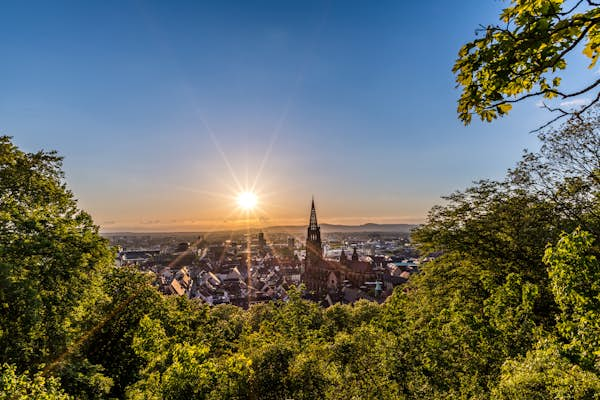Think a trip to Germany ends when you’ve been clubbing in Berlin and hiking in Bavaria? Not so fast. Sure, big cities like Berlin, Munich, and Frankfurt might host the vast majority of Germany’s tourists. But move off those well-trodden paths to Germany’s wealth of smaller cities and you’ll be rewarded with surprisingly youthful energy.
Cities in Germany’s north, south, east, and west double down on the things young people care about – nightlife and entertainment, sure, but also art and sustainability – which exist side by side with centuries-old traditions and landmarks. The juxtaposition is so invigorating you might end up not missing Berghain at all.
For even more youthful excursions, check out German Summer Cities.

Wend your way through the arty alleys of Bremen
‘Expressionism’ isn’t usually a word you might associate with architecture, but take one stroll down Bremen’s Böttcherstrasse and you’ll forget all about Munch and Kandinsky. The red brick may be traditional, but the undulating waves that ripple through the buildings, statues, and fountains give the street a surrealist quality reminiscent of the better-known Expressionist paintings. You can thank coffee for that: the street began its transformation from medieval coopers’ lane to Expressionist heaven at the behest of coffee magnate Ludwig Roselius, who clearly had a penchant for whimsy.
From Böttcherstrasse it’s only a five-minute amble to the Schnoor district, Bremen’s riverside epicenter of living history. It’s a warren of winding alleys and dead ends that might have been a little dicey when this area was a fisherman’s quarter – and red-light district. These days, the only merchants plying their wares are the owners of trendy boutiques in adorably diminutive cottages, and restaurateurs catering to jolly locals. You’d do well to join them for a tipple.

Commune with art’s past and present in Saarbrücken
When school is in session, around ten percent of Saarbrücken’s population are students. The city, which borders France’s Lorraine region, is home to one of the largest universities in southern Germany, the Universität des Saarlandes. The campus itself is pretty, set amidst rolling woodland hills just outside the city. But the university is close enough to Saarbrücken that its youthful energy spills out into the city’s entertainment options. Live music abounds here: for jazz and blues, check out who’s on the lineup at Jules Verne. For punk, metal, and other varietals of rock, head to Garage, appropriately housed in a former industrial space.
If Saarbrücken’s wealth of baroque architecture inspires you to check out what was hip and edgy last century, look no further than the Moderne Galerie. The Impressionists were the enfants terribles of the art scene in the 19th century; they scandalized the art world by setting up their easels outdoors whenever the mood struck and dashing off paintings with quick brush strokes before the light could change. The Moderne Galerie has one of the best collections of Impressionist painting in the world, including works by Monet and Renoir. But the building itself is also worthy of reflection: it was originally constructed in the post-war years to house artworks the Nazi party had deemed ‘degenerate’.

March to the beat of the coolest drummer, in Leipzig
Leipzig is a city even black-clad, terminally unimpressed Berliners think is cool. It’s true, though, that the city has long been a nerve center for young, edgy creative types with deep connections to the past as well as imaginative visions of the future. It was here, after all, that people launched the peaceful protests in 1989 that led to German reunification.
The Museen im Grassi houses three astounding collections, each in its own dedicated museum. For our money, the Museum für Musikinstrumente is first among equals. Here, visitors have the chance to engage the senses and intellect, with Leipzig’s five centuries of rich musical history. The museum’s current collection includes more than 9,000 items, including every musical instrument you can possibly imagine.

Fifteen minutes by foot brings you to another Leipzig standout whose collection spans the centuries: the Museum der Bildenden Künste. There’s not much chance of missing it, as the building is a giant cube with massive panes of glass allowing the northern European grey to illuminate the Munch and Monet masterpieces lining the walls. Also on display is one of Germany’s largest sculpture collections, as well as several rooms devoted to Leipzig’s art history.
Flirt with adventure in the hills above Freiburg im Breisgau
From a bird’s-eye perspective, Freiburg looks more like Rio de Janeiro than it does Berlin or Hamburg – well, a scaled-down version anyway. The city spills out across the valley floor, punctuated by green mountains rising amid gabled houses, soaring medieval architecture, and plazas straight out of a storybook. The fairy tale continues outside the city limits, where the wonders of the Black Forest await.

Hikers of all inclinations can head for the hills from Freiburg’s Schwabentor, a 13th century gate with a mural depicting St. George and the hapless dragon. Punters can hike 800m from here up to the sweet lookout tower at the top of the Schlossberg (then catch the Schlossbergbahn cable car back down if you’re feeling your knees). More serious walkers can carry on 17km to the Abbey of Saint Peter in the Black Forest, dating to the 11th century. A different 25km hike takes adventurous travelers to Kandel mountain, a prime spot for witch-spotting in medieval times. Legend has it that the shapeshifting witch Gfällrote haunts the area to this day, identifiable only by her red eyes and the two dogs – kept alive by black magic – that accompany her everywhere.
Whether or not you spot a witch, the cozy cafes spilling out onto the plazas of quaint Freiburg are a welcome respite from days spent tramping in the hills.
